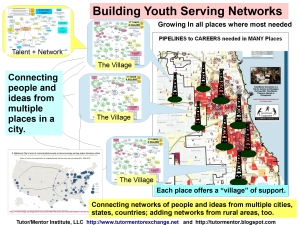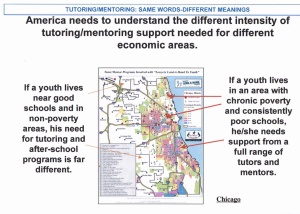 I’ve used maps for nearly 20 years to show where poor schools are located and where acts of violence take place…. in an on-going effort to mobilize more people to support mentor-rich non-school tutor/mentor programs in these places.
I’ve used maps for nearly 20 years to show where poor schools are located and where acts of violence take place…. in an on-going effort to mobilize more people to support mentor-rich non-school tutor/mentor programs in these places.
I’ve also been building a resource library starting in the 1970s when I first became a leader of a volunteer-based tutor/mentor program in Chicago (since 1998 a web library) .
On a regular basis I add new articles to the library and I use my newsletters, blog articles and social media posts to point to research done by others that reinforce these points, as well as to news stories that bring attention, but not solutions.
In 2012 I wrote this article and pointed to a report titled: Place Matters for Health in Cook County: Ensuring Opportunities for Good Health for All. A Report on Health Inequities in Cook County, Illinois. It was prepared by the Joint Center for Political and Economic Studies Health Policy Institute and the Cook County, Il, Place Matters Team
In the introduction the first paragraph says “Where one lives may be the most important factor in determining health outcomes. And because of our history of racial oppression and the legacy of that oppression in residential patterns today, the intersection of place and race in the persistence of health disparities looms large.”
The Executive Summary provides this motivation for citizens throughout the Chicago region to be concerned and involved. “Clearly, there is a strong moral imperative to enact policies to redress the inequities of the past, as well as current inequities, in ways that will improve health for all. But, there also is a powerful economic incentive. A study released by the Joint Center for Political and Economic Studies in 2009 found that direct medical costs associated with health inequities among African Americans, Hispanics, and Asian Americans approached $230 billion between 2003 and 2006. When indirect costs, such as lowered productivity and lost tax revenue resulting from illness and premature death, were included, the total cost of health inequities exceeded $1.24 trillion.7 Thus, for both moral and economic reasons, we must address health inequities and their root causes now.”
In the 2012 article I pointed to this Chicago Tribune article, titled “Violence takes a toll on child’s play.” which also draws attention to “place” and the challenges that face parents, schools and children in these neighborhoods.
 I wrote that “I hope that one of these articles will make some of you concerned enough to launch a “learning group” in your company, family, faith group, alumni group, etc. Only when more people are engaged with the information and actively involved in building youth support programs in all of the poverty neighborhoods will we ever have enough people involved to change these conditions.”
I wrote that “I hope that one of these articles will make some of you concerned enough to launch a “learning group” in your company, family, faith group, alumni group, etc. Only when more people are engaged with the information and actively involved in building youth support programs in all of the poverty neighborhoods will we ever have enough people involved to change these conditions.”
In the five years since then I’ve continued to find research that points to where you live as a determining factor for how you live. Look in this section, and this section, of the Tutor/Mentor web library.
Today I added two new articles to this library:
- Does Where You Live Affect How Long You Live? This link points to a Robert Wood Johnson Foundation page with maps of various cities that show the life expectancy differences based on where you live.
- The above link points to The Center for Society and Health web site at VCU, which has life expectancy maps for 21 metro areas, including Chicago.
Both of these web sites include many additional resources, including ideas for sharing this information.
This month recognizes the 50th Anniversary of the Kerner Commission report on Race & Inequality in America. On Feb 28-March 1 a conference at the Hass Institute of UC Berkeley reviewed progress, or lack of progress. see link
 On Twitter the #Kerner50 hashtag will get you into a conversation about this anniversary. For instance, I found this New York Times commentary, by Fred Haas, the last surviving member of the Kerner Commission.
On Twitter the #Kerner50 hashtag will get you into a conversation about this anniversary. For instance, I found this New York Times commentary, by Fred Haas, the last surviving member of the Kerner Commission.
My 2012 article is one of more than 1000 that I’ve posted on the Tutor/Mentor blog since 2005. I have used printed newsletters (1993-2002), email, web sites and blog articles over the past 25 years to try to draw more people to this information and into discussions and actions that would distribute needed resources and support systems to all of the high poverty neighborhoods of Chicago (and other cities).
For future generations to look back 50 years from now to understand progress made on these issues, new leaders will need to continue building and maintaining web libraries and reaching out to draw people together to read, reflect, discuss and then give time, talent, dollars and votes to support solutions in many places.
If you’d like to help me do this work, or continue it into the future, make a contribution using the PayPal on this page. Or reach out to me via one of these social media platforms.


I didn’t realize you’d migrated from the blogger platform to WP — or rather had moved without bringing archives. The former iteration is the one in my feed reader — so I just added this one to the reader but may need to add more tags for different folders.
LikeLike
Aha — I see you have both still active — somewhat confusing but I do the same thing, keeping multiple blogs. Anyway both are now tagged for alt.ed and education. I should (and probably will) start a separate folder.
If you haven’t come across Bryan Alexander’s #FOEcast yet, check it out. Futuring plans for education there include mentoring and tutoring.
More about it, https://docs.google.com/document/d/1H9csCgima4ZwmDgRAHYL5_GKcQeT_OEzztxyfr8–4s/edit
Add your thoughts, https://docs.google.com/document/d/1H9csCgima4ZwmDgRAHYL5_GKcQeT_OEzztxyfr8–4s/edit
LikeLike
oops — meant to add this for “more” https://bryanalexander.org/tag/foecast/
LikeLiked by 1 person
Thanks for the link to Bryan’s site. I connected with him a couple of years ago in a group reading of Robert Putnam’s “Our Kids” book. I have started reading about the work he’s been facilitating since early February, beginning with his introduction. As I read forward I plan to post comments and resources. Hopefully by next week I’m somewhat caught up. It looks like a huge amount of information to digest, which is one of the challenges “re thinking” systems and engaging a world-wide network presents.
LikeLike
I’ve been following all along and am still overwhelmed. There are quite a few ed tech and mid-level admin sorts who are thinking at the institutional level and mostly about colleges — but not all. Most do have a keen sense the system needs more than just an upgrade. I see more interest in tutor and self-paced systems —
as well as small ground level local projects — than I expected.
LikeLiked by 1 person
Thanks for following my blogs. I set up the WordPress blog in 2017 while I was part of an on-line course hosted by VCU. While my other two focus on building non-school tutor/mentor programs and uses of GIS maps, I wanted to try to expand this one to show role of information in solving problems, which has wider application than youth tutor/mentor programs. ”
In addition, I wanted something with Tutor/Mentor Exchange in the name, since that’s the address of the site I use for Tutor/Mentor Institute, LLC. We picked the name in 1998 when we felt “exchanges” were going to become popular. The name “Institute” resulted from me setting up one page with pdf articles which I used to visualize strategies. From 1998-2005 this was the only site where I could easily upload my pdf collection. In 2011 when I needed to create an organizational structure for my work I used that name and web site.
I’m sure it is confusing for me to use two names: Tutor/Mentor Connection (1993-present) and Tutor/Mentor Institute, LLC (2011-present). The only difference between them is the tax status.
LikeLiked by 1 person